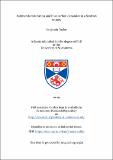Files in this item
Saltmarsh restoration and blue carbon dynamics in a Scottish estuary
Item metadata
| dc.contributor.advisor | Paterson, D. M. (David M.) | |
| dc.contributor.author | Taylor, Benjamin | |
| dc.coverage.spatial | xi, 202 p. | en_US |
| dc.date.accessioned | 2020-11-03T10:52:24Z | |
| dc.date.available | 2020-11-03T10:52:24Z | |
| dc.date.issued | 2019-12-03 | |
| dc.identifier.uri | https://hdl.handle.net/10023/20891 | |
| dc.description.abstract | Saltmarshes are biogeomorphic intertidal systems of halophytic plant communities, typically found on low-energy temperate coasts. These provide valuable ecosystem services, such as biodiversity provision, coastal protection and climate change mitigation. They are sites of extensive carbon sequestration and storage, termed Blue Carbon, largely attributed to their deep organic rich sediments which continue to build with marsh development. Saltmarshes are amongst the most threatened ecosystems globally, estimated to have lost over 25 % since 1800s. Their past and future losses require action to be taken to conserve and restore this valuable ecosystem. Restoration can be achieved through direct-transplantation of existing vegetation onto potential saltmarsh habitat within an estuary. This approach has been carried out on the Eden Estuary, Scotland since the start of the millennium. Restoration aimed to enhance the degraded saltmarsh of the estuary. These areas are likely to increase carbon sequestration and storage capacity of the ecosystem; this capacity was investigated during this study. The Blue carbon benefit afforded by restored saltmarsh areas was compared to the ‘business as usual’ mudflat and the possible end point state of a ‘natural’ saltmarsh extent. The study assessed the influence of vegetation structure, sediment dynamics and buried sediments on the area’s carbon sink. Restoration activities have increased the current total amount of carbon stored in sediment and vegetation by over 0.5 t, and furthermore, contain the largest sedimentary carbon store per unit area, of 23.48 kgC m². Areas of restoration exhibited, on average, higher rates of carbon burial than found on mudflats, being 14 gC m² yr⁻¹. At present their relatively small extent limits their added value to both store significant quantities of carbon and provide a monetary self-subsidisation. In the future it is likely their value will increase as a function of their increased spatial extent and temporal development. | en_US |
| dc.language.iso | en | en_US |
| dc.publisher | University of St Andrews | |
| dc.subject.lcc | QH541.5S24T2 | |
| dc.subject.lcsh | Salt marsh restoration--Scotland--Eden River Estuary | en |
| dc.subject.lcsh | Carbon sequestration | en |
| dc.title | Saltmarsh restoration and blue carbon dynamics in a Scottish estuary | en_US |
| dc.type | Thesis | en_US |
| dc.contributor.sponsor | Marine Alliance for Science and Technology for Scotland (MASTS) | en_US |
| dc.contributor.sponsor | Scottish Natural Heritage (SNH) | en_US |
| dc.contributor.sponsor | British Society for Geomorphology (BSG) | en_US |
| dc.type.qualificationlevel | Doctoral | en_US |
| dc.type.qualificationname | PhD Doctor of Philosophy | en_US |
| dc.publisher.institution | The University of St Andrews | en_US |
| dc.rights.embargoreason | Embargo period has ended, thesis made available in accordance with University regulations | en |
| dc.identifier.doi | https://doi.org/10.17630/10023-20891 | |
| dc.identifier.grantnumber | HR09011 [MASTS] | en_US |
The following licence files are associated with this item:
This item appears in the following Collection(s)
Items in the St Andrews Research Repository are protected by copyright, with all rights reserved, unless otherwise indicated.

